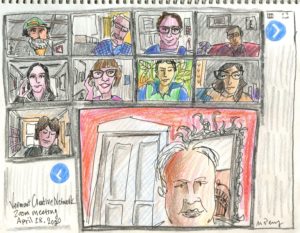August
2020
August 3, 2020
Oregon, Utah, Vermont: Supplementary COVID-19 Relief
The Coronavirus Aid, Relief and Economic Security (CARES) Act included $150 billion in federal funding assistance for states and localities. These dollars (separate from funds distributed through the National Endowment for the Arts) are available to help state and county governments address unanticipated costs of COVID-19. States may elect to use some of the funds for grants to mitigate economic disruptions caused by the pandemic.
Some state arts agencies have capitalized on this opportunity to secure supplemental funding for the arts. Provided through either legislative or executive action, these funds support the creative economy, providing respite from the unique challenges that arts organizations face while venues and activities must be suspended due to COVID-19. Oregon, Utah and Vermont offer insightful examples into the process by which additional funding is secured and then quickly distributed to those in need.
NOTE: As COVID-19 continues to disrupt the economy at large, many states are in the process of allocating supplemental CARES Act funding to support state arts agencies, arts and culture organizations, and creative businesses. These allocations are often appropriated through the legislature or created through executive action and are distributed as grants. For inquiries on COVID-19 supplemental allocations for arts and culture, including examples of state arts agency requests for funding and grant programs, contact NASAA Research Associate Declan Wicks.
Oregon

A four-year-old paints chalk hearts on her sidewalk as part of Crossroads Carnegie Art Center, Inc.’s Yard Art Competition. Photo courtesy of Oregon Cultural Trust
In Oregon, the Oregon Cultural Trust—funded through tax credits and a sister agency to the Oregon Arts Commission—helps fund cultural grant programs in collaboration with Oregon Humanities, the Oregon Historical Society, the Oregon Cultural Heritage Commission, the Oregon State Historic Preservation Office and Business Oregon. As the state legislature was planning for the deployment of Oregon’s CARES Act allocation, the Cultural Trust released research quantifying the impact of COVID-19 on 330 organizations in the state’s arts and culture sector: an estimated $40 million loss with an average loss of $121,281 per cultural nonprofit by June 30. Testimony from the business and cultural community also voiced an urgent need for relief funding. The Emergency Board of the Oregon legislature ultimately authorized $50 million in federal CARES Act funds for immediate use in cultural relief.
Of this $50 million, $24 million is allocated in grants to more than 80 for-profit and nonprofit cultural organizations via dedicated line items and an independent venue fund. The other $26 million is allocated to the Cultural Trust for statewide relief funding, which will be distributed through the Trust’s coalition of county and tribal partners. A priority is to guarantee the equitable statewide distribution of these funds. The proposed funding plan will be considered by the Cultural Trust Board on August 6, and all funds must be dispersed by September 15. For more information, contact Oregon Arts Commission Executive Director Brian Rogers.
Utah

One of a series of eight paintings by Stewart Seidman depicts his personal journey through loss during COVID-19. The painting is currently featured at the Sears Art Museum in St. George. Photo courtesy of Utah Division of Arts & Museums
For Utah, additional COVID-19 relief was connected to the state’s comprehensive COVID-19 Economic Recovery Program passed by the state legislature in June. Of the $62 million allocated from the Utah Coronavirus Relief Fund, $9 million was set aside to create the COVID-19 Cultural Assistance Grant Program. Known as Create in Utah, the grant program is administered by the Utah Division of Arts & Museums. Create in Utah is geared toward helping the largest cultural, artistic, botanical, recreational and zoological organizations (those with an average operational expenditure of $5 million or more per year). Applications for these grants opened July 13 and will close August 7. All funds must be distributed by the end of the calendar year.
The Create in Utah grants will free up funding for smaller organizations that will not need to compete with the largest cultural organizations for operational support grants in fiscal year 2021. Alongside the Create in Utah program, $1 million was also appropriated for use in a partnership between the Division of Finance and the Division of Multicultural Affairs, a sister agency of Arts & Museums under the Department of Heritage & Arts, to provide for digital equipment, basic needs and translation services related to COVID-19. To learn more, contact Utah Division of Arts & Museums Executive Director Victoria Panella Bourns.
Vermont

Drawing of an online Vermont Creative Network meeting by artist and Vermont Arts Exchange Executive Director Matthew Perry
Supplemental COVID-19 relief also was provided through the legislature in Vermont. Recognizing that the arts sector is critical to Vermont’s economic recovery, legislators appropriated $5 million from the Vermont Coronavirus Relief Fund to be granted by the Vermont Arts Council to nonprofit arts and cultural organizations. The $5 million has been designated for a new grant program to help nonprofit arts organizations that support activities for the public and have suffered a reduction of 50% or more in revenues from COVID-19 in any one-month period. This funding will be incredibly valuable, especially considering that the Vermont Arts Council estimates that Vermont’s creative sector will see a loss of $36 million by the end of summer.
Grant awards are calculated to equal 10% of the previous fiscal year’s program revenue, up to a maximum of $50,000. To consolidate the application process for administering the state’s CARES Act relief funds, the application for this grant has been built into the larger Vermont Emergency Economic Recovery Grants program, housed under the Agency of Commerce and Community Development, which supports businesses and nonprofits alike. The arts council is promoting the availability of these new funds and hosting virtual office hours to help creative-sector businesses and organizations apply. Find out more from Vermont Arts Council Executive Director Karen Mittelman.
In this Issue
From the President and CEO
State to State
Legislative Update
The Research Digest
Announcements and Resources
More Notes from NASAA
SubscribeSubscribe
×
To receive information regarding updates to our newslettter. Please fill out the form below.
